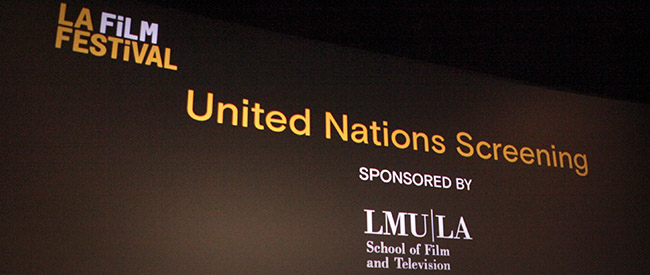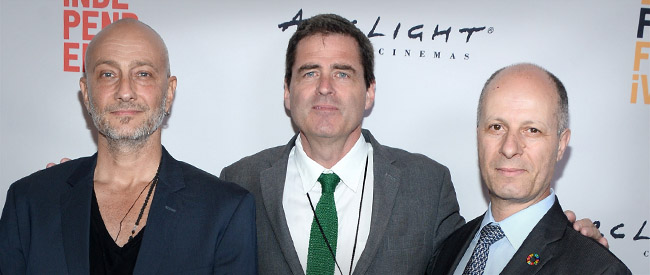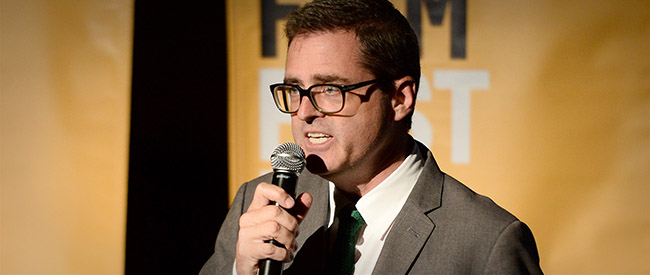LA Film Festival Hosts Exclusive U.N. Work-in-Progress Screening of ‘A Good Day to Die: Hoka Hey’ Doc
It’s a tattoo on his forearm: the words Hoka Hey colored with the yellow, blue and red of the Colombian flag—a phrase photojournalist Jason Howe encountered while documenting the civil conflict in the South American nation. Initially, Howe thought it might be Spanish. But the phrase is actually Sioux, and are most often associated with Lakota tribe leader Crazy Horse, who’d cry the words as he charged into battle. Translated literally, it means let’s go or let’s roll. But one popular mistaken interpretation has tied it to another idea:
It’s a good day to die.
Howe (and his career) is the subject of a new documentary, A Good Day to Die (Hoka Hey), which played out-of-competition as a special work-in-progress screening this past Sunday, June 7 at the 2016 LA Film Festival, followed by a conversation with director Harold Monfils, Maher Nasser, the Director of the UN’s Outreach Division, and Film Independent President Josh Welsh. The event was sponsored by the Loyola Marymount University School of Film and Television.
The film documents Howe’s career as a photojournalist working in some of the world’s most dangerous conflict regions: Colombia, Lebanon, Iraq and Afghanistan. The Kuala Lumpur-based Monfils was looking for a thrilling documentary subject to work on outside of his advertising career. Eventually he found Howe, who would become the focus of his second nonfiction feature. Monfils likened Howe’s life story like that of Hergé’s Tintin, the boy adventurer from the Belgian comics Monfils grew up devouring as a child. “If Tintin was a war photographer, his name would be Jason,” he said.

After Monfils and Howe spent a month discussing the project together, Howe joined the director in Kuala Lumpur for three days to film their first interview. Howe and Monfils subsequently met for additional interviews in Thailand and Spain. “I would meet up with [Howe] two, three, four times a year,” said the director.
That process started in June 2010. Now, in June 2016, the journey is finally nearing its end. But not without a quick, pre-picture-lock pit stop at the LA Film Festival in Culver City, CA.
In its current form, the film combines Howe’s interviews with photos and video footage of the conflicts Howe sought to document as both a profession and a calling. The audience vicariously experiences some of the horror Howe faced every day on the job, and gets a small taste of the addictive adrenaline involved in pursuing such a visceral line of work.
The film follows Howe’s growth as a photojournalist chronicling both the Colombian FARC rebels and the paramilitary groups charged with hunting them down. We see Howe’s Baghdad hotel bombed by Insurgents. We see Howe narrowly miss stepping on an IED charge, only to have the soldier following behind him set the explosive off, losing both of his legs.
Howe spent years fighting, going to extreme lengths to tell important stories through his pictures. And some fights even extended past the camera. Government censorship and state-sponsored media outlets threatened to shut him down, like when the Ministry of Defense tried to block the images of the British soldier who lost his legs.
To this, in the Q&A Nasser emphasized the importance of a free press, saying: “Journalists and media are very important in opening things up.”
In all situations, Howe took pictures that document the grim realities of modern warfare. Part and parcel with this is the changing civilian experience. “Today’s wars are different,” explains Nasser. “[In] the First World War, the majority of casualties were actually combatants. Today, the majority of casualties are civilians.”
Non-state actors like terrorists have changed the global practice of violence. Journalists and photojournalists like Howe are charged with exposing these realities, bringing them front and center in the popular conscience. “In the last 10 years, more than 825 journalists were killed covering not just war, but also corruption and organized crime. What is more horrific is that in 90% of the cases nobody is actually held accountable,” said Nasser.

Further complicating the job of these professionals in the new influx of freelance photographers with little or no training or military zone experience, no companies to insure them and tactless behavior dealing with local populaces. Swarms of amateur photographers are seen in the documentary crowding around victims, getting in the way of emergency responders—even sabotaging the work of other photographers.
As the professionals in the film said to Monfils about this new breed of freelancers: “They tend to get hurt, they tend to get killed, they tend to get injured. And many times an injury doesn’t mean it’s fatal. But if you don’t know what you’re doing, it will be fatal.” Unschooled photographers take the focus away from bringing attention to these conflicts, making it about who can get the most up close and shocking image.
“This made a huge impact on Jason because it changed the way he looked at his own profession,” said Monfils. Howe, like many war photographers, suffers from symptoms associated with PTSD (Howe has never received and official diagnosis). In addition, he had become romantically involved with a paramilitary assassin named Marilyn who was eventually killed, adding to Howe’s heavy trauma. Eventually, Howe self-medicating with drug-fueled trips to Thailand and trips to Colombia.
Monfils was wary of overstepping the intimacy he and his subject had developed, making sure not to cause additional trauma Howe as he recollected the events. And it took a long time for Monfils to earn Howe’s trust. “The interview about Marilyn took four years,” said the director. Additionally, Monfils knew Howe was in recovery and didn’t want to harm his progress. “This could not have been easy for him,” he said.
Film was born from photography. Both art forms require similar talents, intuitions and desire. Monfils found that he and Howe had much in common, which played a big in part in steering him toward Hoka Hey. “I started in the industry when I was 16, 17 years old,” said Monfils, “I had a dream and something I wanted to do, and I met a man who had an even bigger dream then me, and he went even further. And he’s pushed it to the limit, that it actually just brought him into a downward spiral.”

These days, Howe lives a quiet life in Spain, still on the long road to recovery. These days he works with horses, saying that the animals are helping him in the process of healing a very dark view of the world. As Monfils said, “I started this project because I thought Jason was an amazing photographer.” And the work Howe created during his career in the field is absolutely stunning—but it at great cost.
Monfils, a fan and now a friend as well, wished Howe a solid recovery and a rejuvenated love of photography, adding: “I sincerely hope he picks up the camera again.”
The 2016 LA Film Festival is currently happening at the ArcLight Cinemas in Culver City as additional venues citywide through June 9. Buy your tickets to all of our great screenings and special events today. Click here for more information. Learn how to become a Member of Film Independent by clicking here.